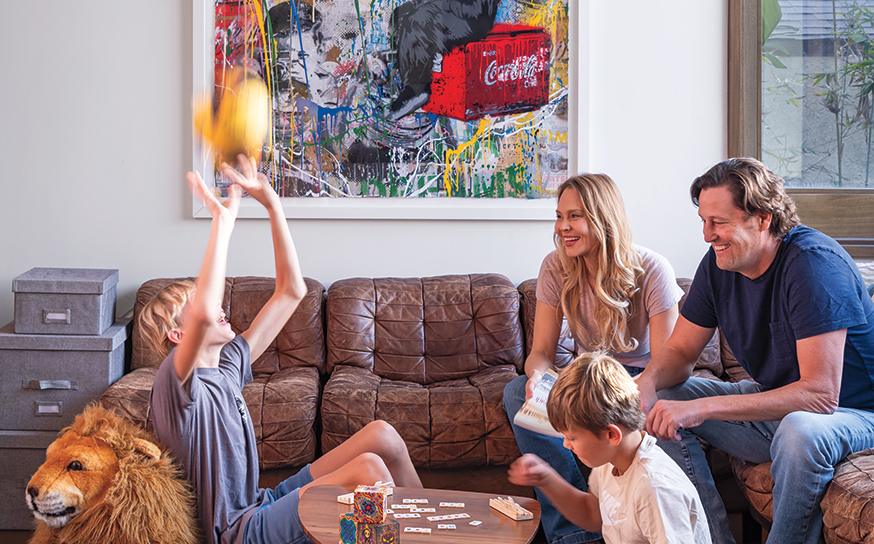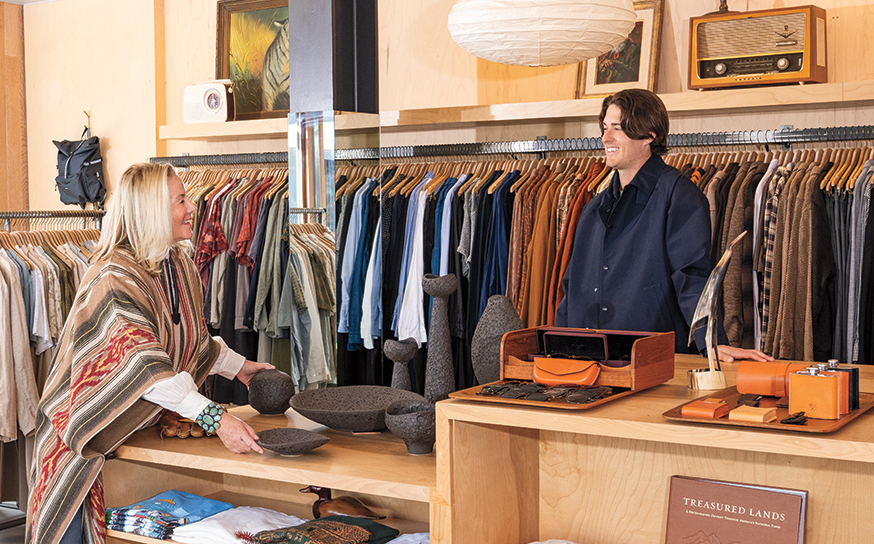How an Organic Mushroom Farm Is Changing Hearts, Minds and the World in Its Own Tasty Way
The future is mushrooms.
- CategoryEat & Drink, People
- Written byRobert Earle Howells
- Photographed byAndrew Carter
Smallhold, an organic mushroom farm near Downtown Los Angeles, looks like a sci-fi rendition of the future of agriculture. A long concrete hallway flanked by climate-controlled chambers. Everything clinically clean. Lab-coated technicians scurrying about. On a recent tour, I overheard two of the lab coats casually chatting:
“What did you do this weekend?”
“Went foraging.”
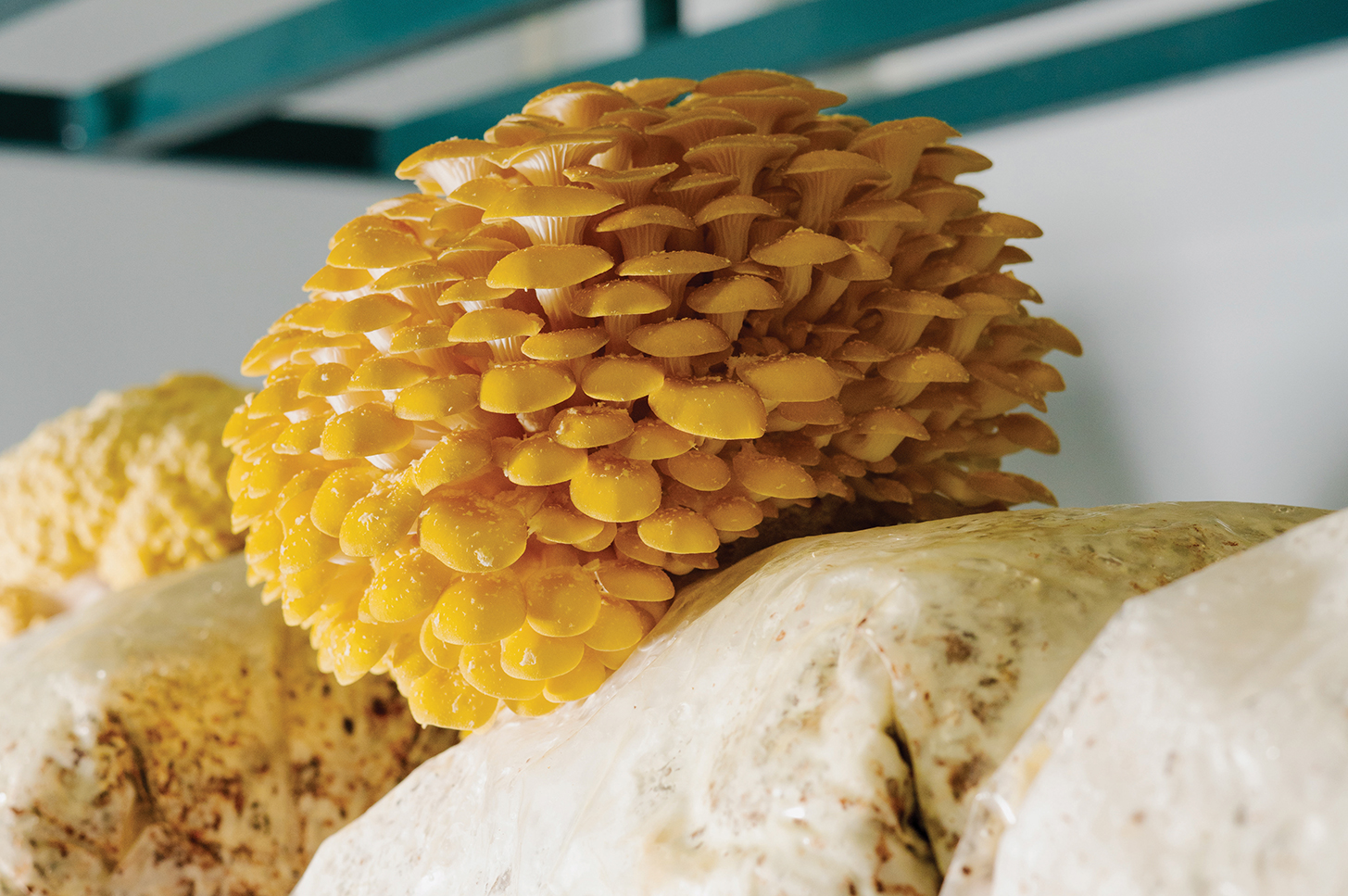
Yellow Oyster mushrooms growing in sawdust substrate
The Smallhold staffers were tending to crops of lion’s mane, trumpet and a handful of other mushroom varieties they grow in the farm’s 34,000-square-foot facility in Vernon. These folks devote their entire working lives to cultivating organic mushrooms—and they spend their off time doing what? Foraging for mushrooms!
I asked my guide if this struck him as ironic. He shrugged. “They’re mycologists. They’re interested in and involved in mushrooms, and that includes the wild versions. So they go foraging.”
“People don’t realize how different these various organisms are. Mushrooms are a kingdom, like plants and animals. Saying you don’t like mushrooms is like saying you don’t like plants.”
Later the cofounder of Smallhold, Andrew Carter, elaborated a bit: “Mushrooms have an amazing way of getting people enamored.” He wasn’t just talking about mycologists, nor only chefs and buyers for stores like Whole Foods.
“Mushrooms are fun,” he says. “Lion’s manes look like little alien creatures. People get excited about mushrooms more than I’ve seen with any other product. There are movies, books, T-shirts. People tell their friends about them. It’s a beautiful organism.”
The L.A. native found his way to mushrooms after a stint with the nonprofit TreePeople. He then moved to New York for a brief career as a landscaper before devoting himself to indoor agriculture. “I was interested in ecosystem management—using plants to help steward the environment and accomplish human needs.”
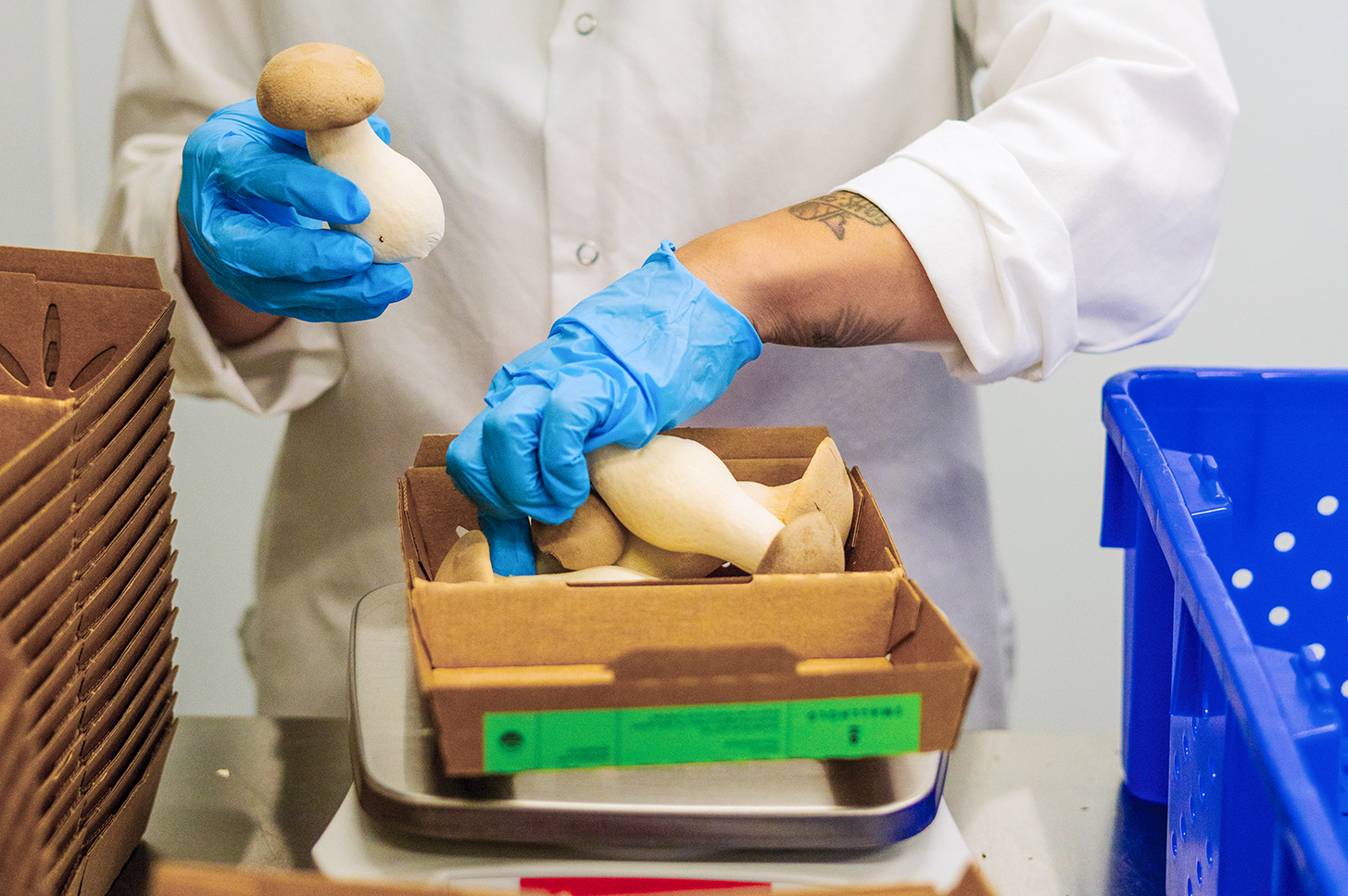
Readying Trumpet mushrooms for shipping
Andrew started growing lettuce and tomatoes indoors, using minimal resources and organic methods, and eventually branched out to mushrooms. He remains zealous about his mission.
“The climate is changing, and the consensus is that it’s changing really fast,” he points out. “Farming isn’t changing fast enough to keep up. If you do it right, you’re imitating environments, and you have to understand those environments to create a framework for what you’re providing for these organisms.”
That’s exactly what I witnessed at Smallhold in L.A., largest by far of the company’s four farms, which include the original in Brooklyn and two in Austin, Texas. Row after row, chamber after chamber—24 in all—I saw long stacks of mushroom-laden shelves behind heavy insulated doors, each with a computer monitor outside indicating the current climatic conditions inside.
Not only are temperature, humidity, oxygen and CO2 levels carefully monitored, but they change in the course of a day—because that’s what happens in the real world. The forest floor warms up, then cools down. Each variety has its own unique “climate recipe” that replicates wild environments.
In total, Smallhold cultivates 14 different varieties, four of them in L.A.: lion’s mane, blue oyster, yellow oyster and trumpet. Notable was the absence of the button mushrooms we all grew up eating. And liking—or not. Which is why Andrew is keen to expand our mushroom consciousness.
“Most grocery stores just sell buttons and portobellos, which really are the same mushroom,” he says. “By producing all these different varieties, we hope people will find some they like. Each has a different flavor, texture, ways of preparing. People don’t realize how different these various organisms are. Mushrooms are a kingdom, like plants and animals. Saying you don’t like mushrooms is like saying you don’t like plants.”
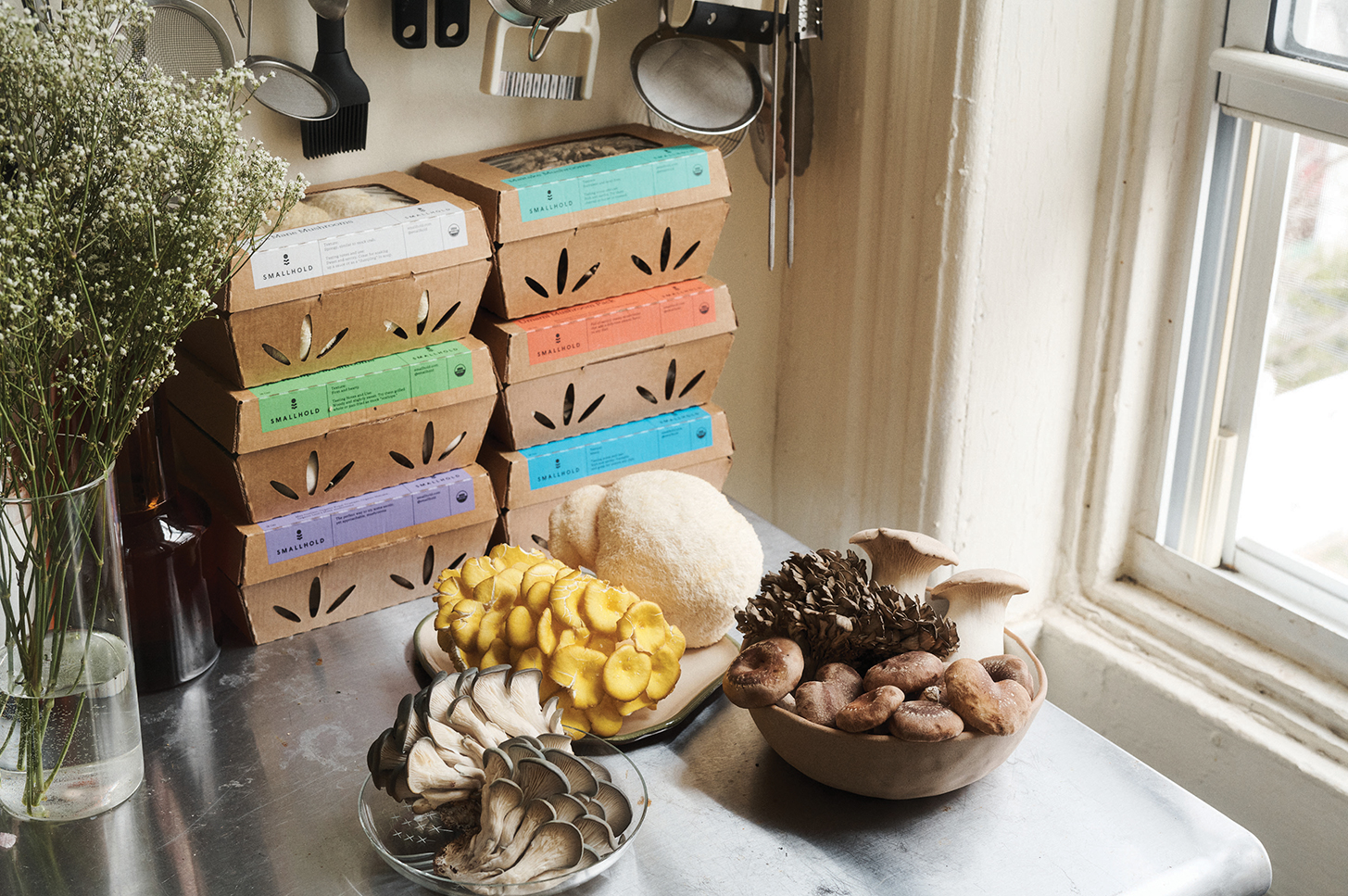
A cornucopia of Smallhold varieties
For skeptics or the mushroom-curious, Andrew suggests buying a cluster of blue oysters. “Then keep it simple. Just roast them with some butter or oil and herbs. It’s hard to overcook them; their cell walls can hold up to heat. Roast them at 350º or 400º and leave them in the oven for 45 minutes to an hour and a half. Take them out and enjoy them with friends and family. Really simple. Later you can make things more and more complicated. Lion’s manes can taste like crabcakes or be made to taste like meat.” (Visit smallhold.com for an array of shroom recipes.)
Smallhold doesn’t have to convince chefs of the beauty of organic mushrooms. Among the company’s local restaurant customers are some of the best eateries in Los Angeles, including Botanica, Lasita, Kismet, Gjelina, Gjusta, Tsubaki, Kali and Rustic Canyon.
Says chef Zarah Khan of Rustic Canyon, “I love Smallhold because it is part of my ethos to source locally. I barely had mushrooms on my menus when I moved to L.A. [from Seattle]. I felt guilty paying for mushrooms from out of state, so when I found out about Smallhold I was elated. There are so many things you can do with each different variety of mushroom, and it sparks my creativity, which I love.”
Smallhold’s L.A. farm, operational for just over a year, is huge. But I was still blown away when my guide informed me that they ship 30,000 pounds a week to distributors who in turn sell them to the likes of Whole Foods, Sprouts, Erewhon, Ralphs and area restaurants.
Even Andrew shakes his head in amazement. “Yeah! We started this thing in a basement, then grew to a shipping container. Now they go out in truckloads loaded with pallets.”
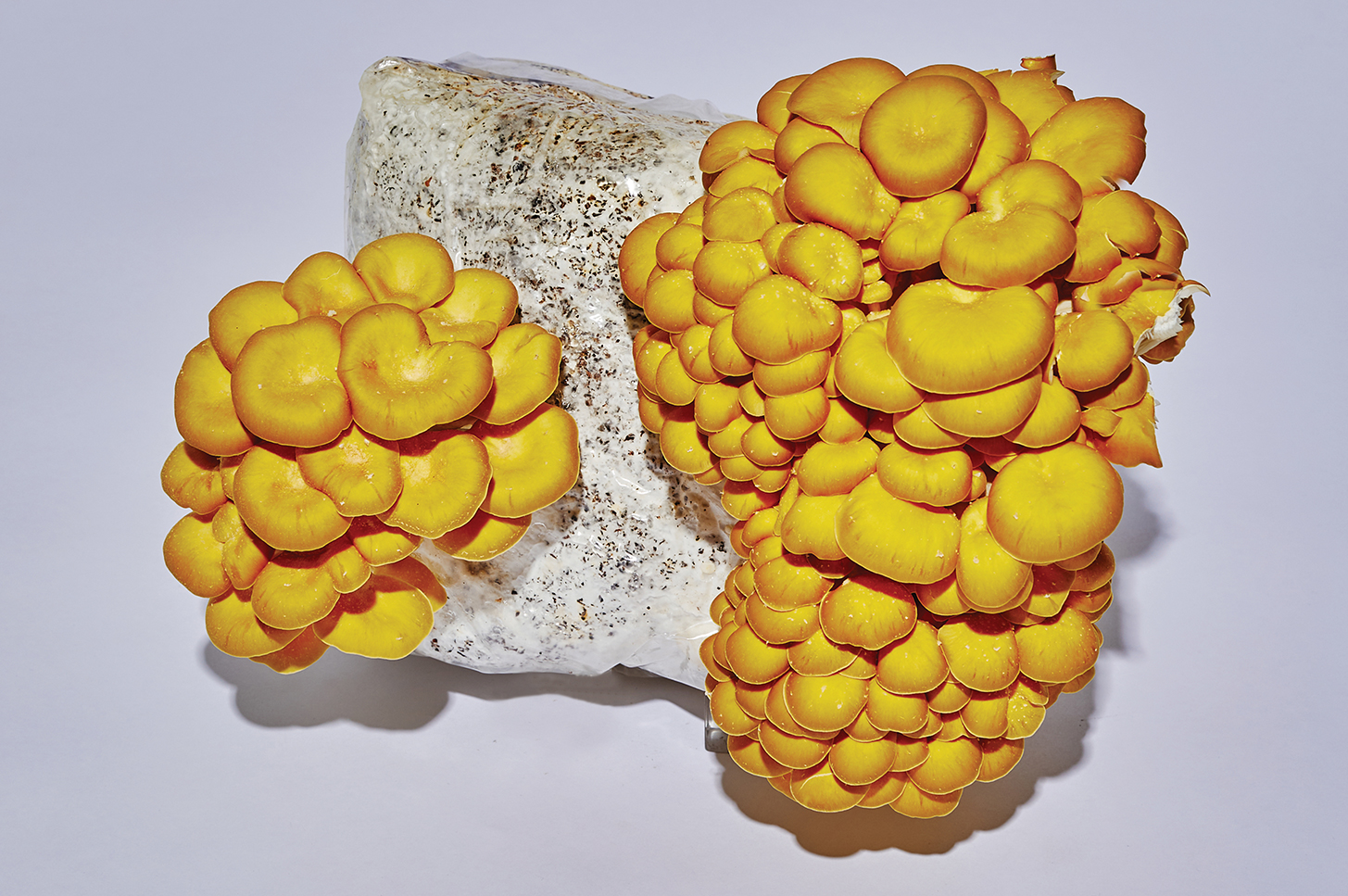
Yellow Oyster mushrooms
Smallhold was the first certified organic mushroom farm in L.A. County, and that certification is something the company takes seriously. I had to verify my good health before entering the farm and wore a mask, gloves, hairnet and lab coat as I toured the über-clean premises.
“We don’t use pesticides or chemicals,” says Andrew. “Even though most contaminants that might affect mushrooms don’t impact humans, we don’t want to use the chemicals that most farms have to use. We also want to be really efficient growing in our space. You’d never find so many mushrooms in one place at one time. In the wild, you might have a couple blue oysters on a log. Here we create the environment and manage it really well.”
Among those methods is Smallhold’s practice of growing their mushrooms in blocks of sawdust substrate rather than in dirt. The substrate is a byproduct of the timber industry, repurposed first for mushroom farming, then donated as compost for local folks to use in their gardens. (Follow @smallhold on Instagram for spent-block pickup dates.)
As successful as Smallhold has been, Andrew and his staff of foraging mycologists consider mushroom growing to be as much about mission as profit. “WE CHANGE MINDS WITH MUSHROOMS,” proclaims a sign at the entrance to the farm. Below that: “By growing mushrooms in communities around the country, we’re helping people reconnect with their food, environment and farmers.”
If they help make your pizza delicious, so much the better.







